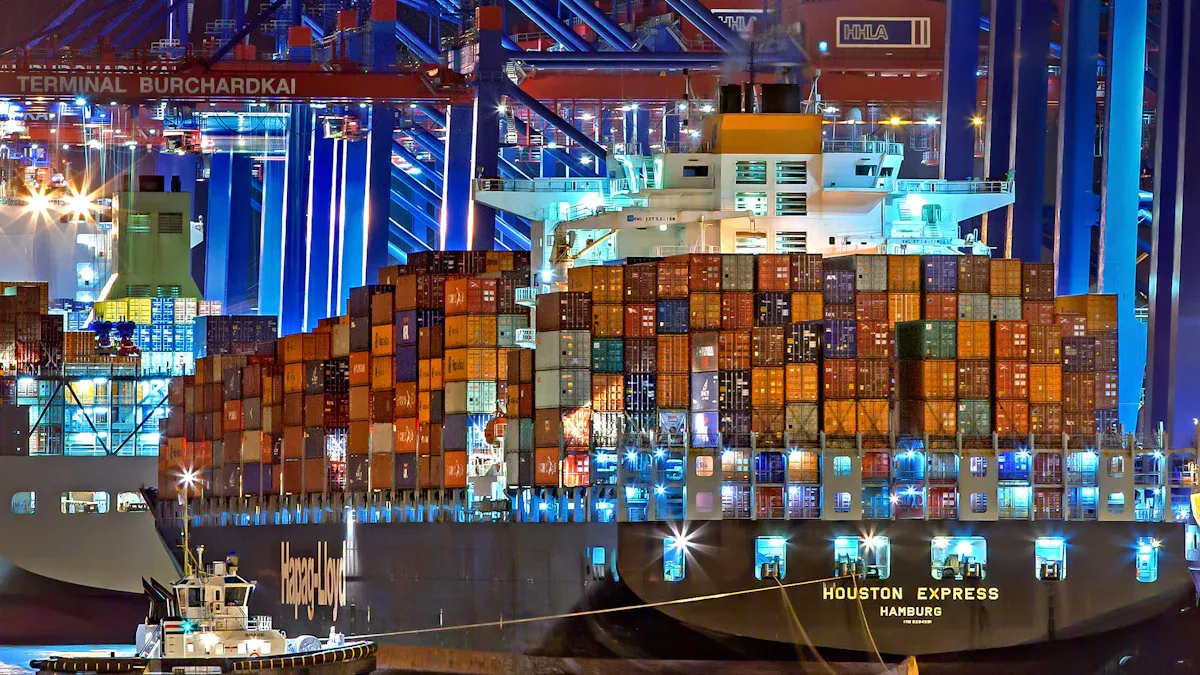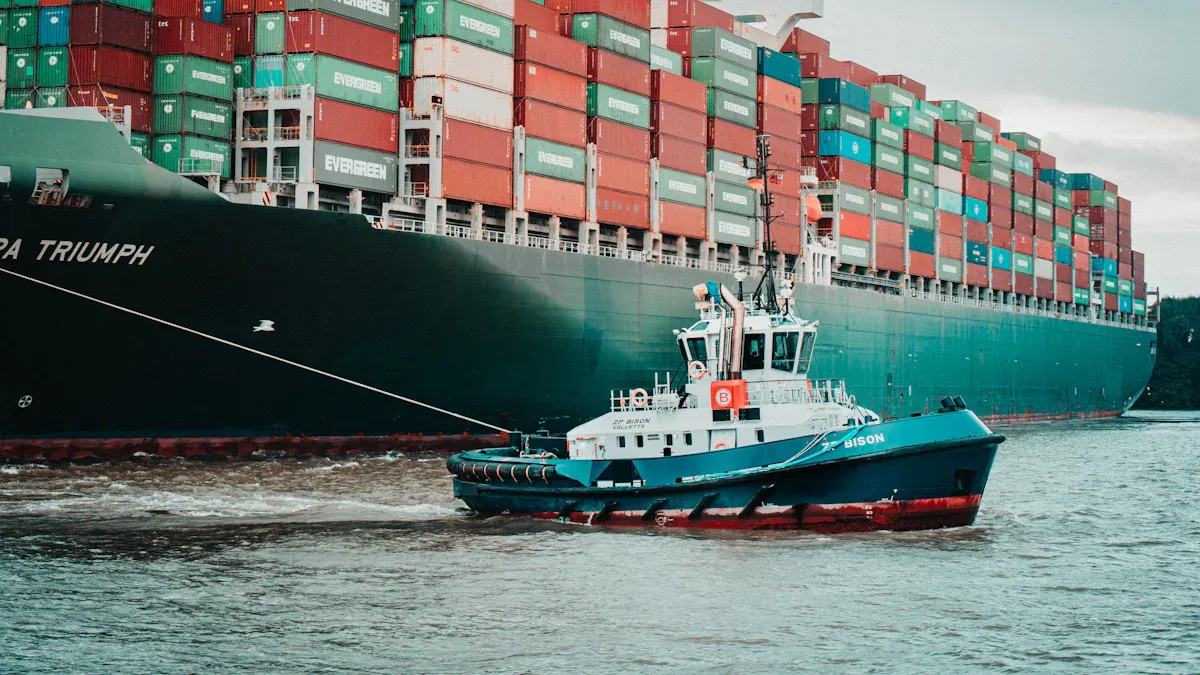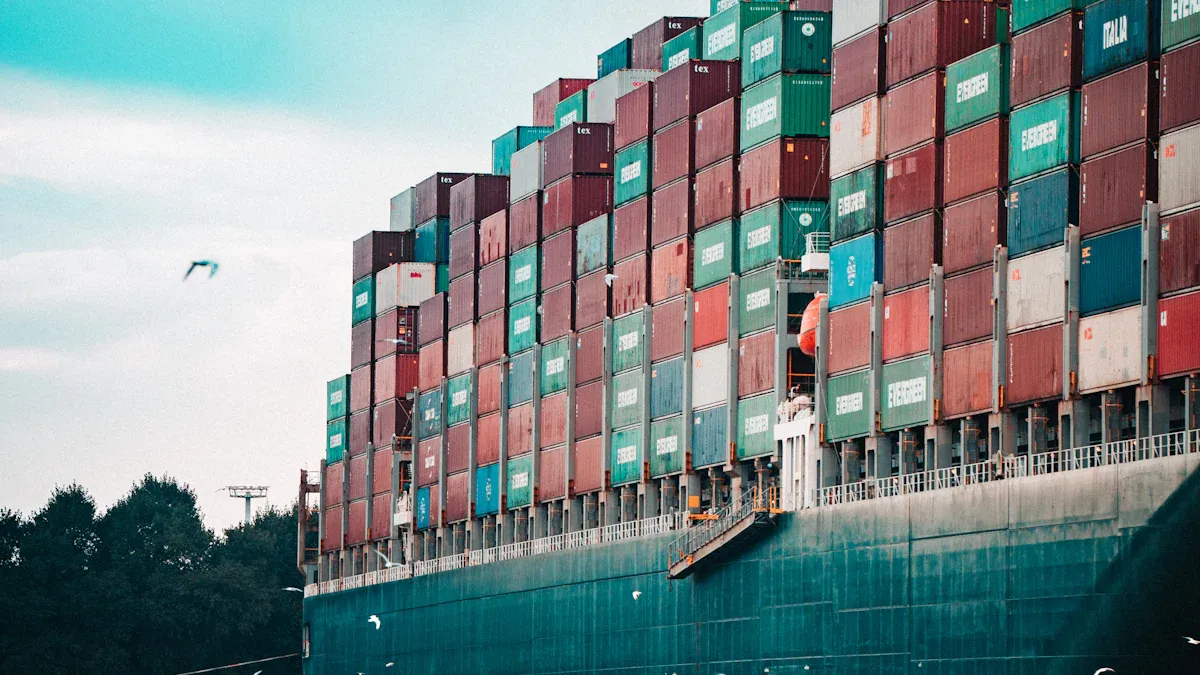India’s Balancing Act: Navigating Trump’s Tariffs and Global Supply Chain Shifts

Global trade has undergone significant disruptions due to Trump’s tariffs and shifting supply chains. These tariffs have impacted economies worldwide, with projections showing a 0.4% decrease in US GDP and a loss of 309,000 full-time jobs. Retaliatory measures have further strained international relations, generating $13.2 billion in tariff revenues. Amid this turmoil, India occupies a unique position. Its high tariffs on US goods and strategic trade policies make it a pivotal player. The question remains: how can India maintain its balancing act while navigating these challenges and opportunities?
Key Takeaways
India charges high taxes on US goods to protect local businesses. This also helps bring in foreign investments and balance trade.
The China+1 plan pushes companies to use more than one supplier. India is becoming a top choice because of its strengths.
Building better technology and roads helps India make products faster. This makes India a good place for global companies to invest.
Businesses coming to India should study the market well. They need to change their plans to match what local people like.
India's economy has many chances to grow in areas like IT, healthcare, and clean energy. Government programs support this growth.
The Global Impact of Trump’s Tariffs

Key Features of Trump’s Tariff Policies
Trump’s tariff policies introduced significant changes to global trade. These measures aimed to protect domestic industries and reduce trade deficits. However, they also imposed substantial costs on international trade partners. Key features of these policies include:
In 2024, imported goods in the U.S. are projected to total $2.9 trillion, with over 40% sourced from China, Canada, and Mexico.
A 25% tariff was applied to all imports from Mexico and Canada, excluding Canadian energy resources, which face a 10% tariff.
On March 26, a 25% tariff on automobiles and specific parts was announced, effective April 3.
These tariffs reflect a strategic approach to reshaping trade relationships, but they have also created ripple effects across the global economy.
Implications for Global Trade Dynamics
The introduction of tariffs has disrupted global trade dynamics. Tariffs act as a negative supply shock, raising prices and limiting economic activity. They also create uncertainty, delaying investment decisions and reducing efficiency. Some key implications include:
Countries that engage in international trade often experience higher economic growth due to better resource allocation.
Comparative advantage plays a vital role in trade patterns, enabling countries to achieve economic efficiencies.
Trade liberalization generally fosters growth, though its benefits are not evenly distributed.
Firms benefit from trade by accessing broader markets, inputs, and technologies, which enhance productivity and innovation.
While tariffs aim to protect domestic industries, they often distort global markets and create welfare losses, as economic theory suggests.
Geopolitical Influences on Supply Chain Realignments
Geopolitical tensions have significantly influenced supply chain realignments. Tariffs and trade restrictions have forced companies to reconsider their sourcing strategies. Indicators of these changes include:
Indicator | Description | Value Change |
|---|---|---|
Global Supply Chain Pressure Index | Quantifies disruptions in global supply networks. Positive values indicate strain, negative values suggest easing conditions. | N/A |
KPMG’s Supply Chain Stability Index | Reflects operational stability, showing a drop from 2.34 in January 2023 to 1.12 in December 2023. | From 2.34 to 1.12 (Jan to Dec) |
These shifts highlight the growing need for businesses to adapt to evolving geopolitical landscapes and ensure supply chain resilience.
The China+1 Strategy and Its Relevance
Understanding the China+1 Strategy
The China+1 strategy refers to the practice of diversifying supply chains by adding alternative manufacturing locations outside of China. This approach emerged in 2013 as businesses sought to reduce their reliance on a single country. Recent events, such as the U.S.–China trade war and China's strict zero-COVID policy, have underscored the risks of over-dependence on China. Companies adopting this strategy aim to build resilience and mitigate disruptions caused by geopolitical tensions or localized crises.
The resurgence of this strategy stems from several factors. Rising labor costs in China have made alternative markets more attractive. Additionally, the COVID-19 pandemic exposed vulnerabilities in supply chains heavily reliant on China. Countries like Vietnam and India have become prominent alternatives, offering competitive advantages in labor, infrastructure, and market access.
Drivers of Supply Chain Diversification
Several key drivers have accelerated the shift toward supply chain diversification. Geopolitical tensions, particularly the U.S.–China trade war initiated in 2018, created uncertainty for businesses. Tariffs and trade restrictions forced companies to reevaluate their sourcing strategies. The pandemic further highlighted the importance of diversification, as lockdowns in China disrupted global supply chains.
Economic factors also play a significant role. Rising production costs in China have prompted businesses to explore cost-effective alternatives. Diversification not only reduces risks but also enhances operational flexibility. By spreading production across multiple locations, companies can respond more effectively to market changes and disruptions.
India’s Role in the China+1 Framework
India has emerged as a key player in the China+1 strategy. Its large workforce, competitive labor costs, and growing infrastructure make it an attractive destination for businesses seeking to diversify. The Indian government has introduced initiatives like the Production Linked Incentive (PLI) scheme to boost manufacturing and attract foreign investment. These efforts align with global trends, positioning India as a viable alternative to China.
India's strategic location further enhances its appeal. It offers access to major markets in Asia, the Middle East, and Africa. Additionally, India's focus on digital transformation and technological advancements strengthens its position in global supply chains. By leveraging these advantages, India can play a pivotal role in reshaping the global trade landscape.
India’s Balancing Act in the Supply Chain Landscape

India as a Neutral Trade Partner
India has positioned itself as a neutral trade partner in the global supply chain landscape. Its ability to maintain balanced trade relationships with major economies has contributed to its growing reputation. Recent trade statistics highlight this trend. India recorded the fastest growth in goods export orders in nearly 14 years, reflecting its improving manufacturing conditions. This growth underscores India's role as a reliable partner for countries seeking to diversify their supply chains.
India’s neutrality stems from its strategic trade policies and non-alignment with major geopolitical blocs. By fostering partnerships with both developed and developing nations, India has created opportunities for businesses to access diverse markets. This approach not only strengthens its trade network but also enhances its resilience in a volatile global economy.
Advancements in Technology and Infrastructure
India’s advancements in technology and infrastructure have bolstered its position in global supply chains. Investments in digital transformation, such as the adoption of Industry 4.0 technologies, have improved manufacturing efficiency. Smart factories, powered by automation and data analytics, enable Indian firms to meet global standards. These technological strides attract foreign investors seeking innovative and cost-effective solutions.
Infrastructure development further supports India’s balancing act. Projects like the Bharatmala and Sagarmala initiatives aim to enhance connectivity and logistics efficiency. Improved road networks, ports, and freight corridors reduce transportation costs and delivery times. These developments make India an attractive destination for businesses looking to optimize their supply chains.
Localization Efforts and Manufacturing Initiatives
India’s localization efforts and manufacturing initiatives reflect its commitment to strengthening domestic industries. Programs like the Production Linked Incentive (PLI) scheme encourage companies to establish local manufacturing units. This approach reduces dependency on imports and promotes self-reliance. Additionally, it aligns with global trends favoring localized supply chains.
Case studies highlight India’s progress in manufacturing. For instance:
Case Study | Description |
|---|---|
1 | Demonstrates operational excellence and lean management practices. |
2 | Explores strategies for reducing waste while maintaining quality standards. |
3 | Examines solutions to address production inefficiencies and disruptions. |
Indian firms also focus on sustainability in their supply chains. Many companies integrate environmental, social, and governance (ESG) factors into their operations. Green manufacturing practices, aimed at reducing carbon emissions and pollution, showcase India’s efforts to balance economic growth with environmental responsibility.
Challenges and Opportunities for Businesses
Navigating Regulatory and Compliance Barriers
Businesses operating in India face significant regulatory and compliance challenges. These include navigating complex legal frameworks and adhering to evolving policies. Key obstacles include:
Insufficient resources allocated to compliance initiatives.
Poor company culture that fails to prioritize regulatory adherence.
To overcome these barriers, organizations must invest in employee training and allocate adequate resources. Building a culture that values compliance can also enhance risk management. By addressing these issues, businesses can improve their operational efficiency and reduce potential legal liabilities.
Strategies for Market Entry and Expansion
Entering and expanding in India’s diverse market requires strategic planning. Companies must consider product-specific factors and assess risks such as political instability, currency fluctuations, and credit challenges. Trade credit insurance often helps mitigate these risks.
Successful market entry strategies include:
Conducting thorough customer research to understand needs and preferences.
Evaluating the financial capabilities of potential buyers for effective pricing.
Testing products or services through pilot campaigns to minimize risks.
Launching in targeted regions or customer segments allows businesses to gather focused feedback. This data-driven approach enables companies to refine their offerings and marketing strategies, ensuring a stronger foothold in the market.
Sectoral Opportunities in India’s Economy
India’s economy offers diverse opportunities across multiple sectors. The service sector, contributing over 50% to GDP, grew by 9.1% in 2022-23, driven by IT, healthcare, and tourism. Manufacturing initiatives like "Make in India" and renewable energy programs such as the National Solar Mission further boost economic potential.
Sector | Contribution to GDP (%) | Growth Rate (%) |
|---|---|---|
Pharmaceuticals | 1.5 | 8.6 |
Automobiles | 7.1 | 9.2 |
Textiles | 2.3 | 6.5 |
India’s agricultural sector also benefits from policies like Minimum Support Prices (MSP) for crops. These sector-specific trends highlight the country’s potential for businesses seeking growth and innovation.
India’s strategic balancing act in navigating Trump’s tariffs and global supply chain shifts highlights its growing role in global trade. Initiatives like the Sagarmala project, with a $54 billion budget, enhance port infrastructure and trade efficiency, strengthening India’s position in the Indo-Pacific. Agreements such as the ASEAN–India Free Trade Area foster economic ties with Southeast Asia, supporting India’s Look East Policy. These efforts underline the importance of policy reforms and infrastructure development in maintaining economic resilience.
Businesses and policymakers should focus on leveraging India’s manufacturing incentives and regional partnerships. Companies can benefit by aligning with India’s localization efforts, while policymakers should prioritize trade-friendly regulations. By fostering global partnerships and investing in infrastructure, India can solidify its role as a key player in the evolving global supply chain.
FAQ
What is the significance of India’s high tariffs on US goods?
India’s high tariffs on US goods protect domestic industries and encourage local manufacturing. However, they also impact trade relations with the US. By balancing tariffs and trade policies, India can attract foreign investment while maintaining its economic interests.
How does the China+1 strategy benefit India?
The China+1 strategy reduces reliance on China by diversifying supply chains. India benefits from this shift due to its competitive labor costs, growing infrastructure, and government incentives like the Production Linked Incentive (PLI) scheme. These factors make India an attractive alternative for global businesses.
What challenges do businesses face when entering India’s market?
Businesses face challenges like navigating complex regulations, managing compliance risks, and understanding diverse consumer preferences. Addressing these issues requires strategic planning, investment in local expertise, and adapting products or services to meet market demands.
How does India’s infrastructure development support global trade?
India’s infrastructure projects, such as the Bharatmala and Sagarmala initiatives, improve connectivity and logistics efficiency. Enhanced road networks, ports, and freight corridors reduce transportation costs and delivery times, making India a key player in global supply chains.
What sectors offer the most opportunities in India’s economy?
India’s economy offers growth opportunities in sectors like IT, healthcare, renewable energy, and manufacturing. Initiatives like "Make in India" and the National Solar Mission further boost these industries, attracting businesses seeking innovation and expansion.
See Also
Addressing Global Supply Chain Growth Challenges Effectively
Understanding Inflation's Impact on Supply Chain Issues
Exploring Jusda's Supply Chains and Global Consumer Needs
Expert Advice for Overcoming Automotive Supply Chain Hurdles
